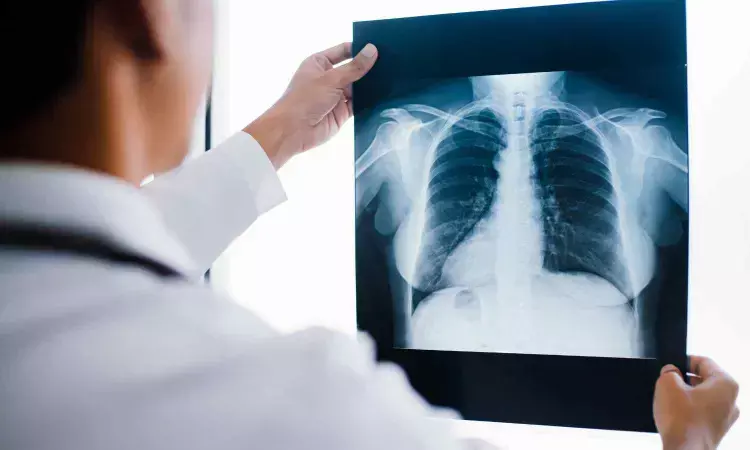- Home
- Medical news & Guidelines
- Anesthesiology
- Cardiology and CTVS
- Critical Care
- Dentistry
- Dermatology
- Diabetes and Endocrinology
- ENT
- Gastroenterology
- Medicine
- Nephrology
- Neurology
- Obstretics-Gynaecology
- Oncology
- Ophthalmology
- Orthopaedics
- Pediatrics-Neonatology
- Psychiatry
- Pulmonology
- Radiology
- Surgery
- Urology
- Laboratory Medicine
- Diet
- Nursing
- Paramedical
- Physiotherapy
- Health news
- Fact Check
- Bone Health Fact Check
- Brain Health Fact Check
- Cancer Related Fact Check
- Child Care Fact Check
- Dental and oral health fact check
- Diabetes and metabolic health fact check
- Diet and Nutrition Fact Check
- Eye and ENT Care Fact Check
- Fitness fact check
- Gut health fact check
- Heart health fact check
- Kidney health fact check
- Medical education fact check
- Men's health fact check
- Respiratory fact check
- Skin and hair care fact check
- Vaccine and Immunization fact check
- Women's health fact check
- AYUSH
- State News
- Andaman and Nicobar Islands
- Andhra Pradesh
- Arunachal Pradesh
- Assam
- Bihar
- Chandigarh
- Chattisgarh
- Dadra and Nagar Haveli
- Daman and Diu
- Delhi
- Goa
- Gujarat
- Haryana
- Himachal Pradesh
- Jammu & Kashmir
- Jharkhand
- Karnataka
- Kerala
- Ladakh
- Lakshadweep
- Madhya Pradesh
- Maharashtra
- Manipur
- Meghalaya
- Mizoram
- Nagaland
- Odisha
- Puducherry
- Punjab
- Rajasthan
- Sikkim
- Tamil Nadu
- Telangana
- Tripura
- Uttar Pradesh
- Uttrakhand
- West Bengal
- Medical Education
- Industry
Opportunistic chest X-rays effective in identifying bone loss risk: Study

A new study published in the Journal of Primary Care & Community Health revealed that it may be possible to detect people at risk of bone loss outside of the conventional screening age range by using chest x-rays opportunistically.
The primary method of osteoporosis screening is dual-energy X-ray absorptiometry (DXA) scans, which measure bone mineral density. Typically, screening doesn't begin until age 65. In primary care settings, where DXA may not be easily accessible, individuals with osteoporosis risk and symptoms of bone demineralization may be identified by the opportunistic use of chest X-rays taken for other purposes.
Between May 1, 2021, and May 31, 2021, this research performed a cross-sectional assessment of the electronic medical records of patients aged 50 to 65 who underwent a chest X-ray at the emergency room of a sizable Level 1 trauma center in an urban teaching hospital. Based on the X-ray data, they calculated the prevalence of "bone demineralization" and contrasted it with the results of a review by an impartial radiologist.
This research also looked into the clinical and demographic correlates of LBM and estimated the number of persons aged 50 to 65 who may be at risk for the disease using data from the 2020 US population census. This study analyzed 390 patient data, including 201 (51.5%) males and 189 (48.5%) females. A radiologist analysis showed 49 (12.6%) reports with a bone demineralization remark, when compared to 4 (1.0%) reports.
This study predicted that roughly 8.4 million persons in the US population aged 50 to 64 will have bone demineralization, based on a sex-adjusted prevalence of 13.1% (using the direct method, using the 2020 US population as benchmark). In women, LBM was linked to hypertension (OR = 2.41, 95% CI = 1.03-5.64).
Overall, using plain chest radiographs obtained for other causes might offer a way to identify people at risk at little or no additional expense to the patient, even if mass screening for osteoporosis or bone demineralization in all persons aged 50 to 65 is not currently advised.
Source:
Chinapuvvula, N. R., Hatley, M., Khan, R., Awiwi, M., des Bordes, J., & Rianon, N. (2025). Opportunistic use of chest X-ray for identifying older adults at risk of osteoporosis and not meeting criteria for screening. Journal of Primary Care & Community Health, 16(21501319251353372), 21501319251353372. https://doi.org/10.1177/21501319251353372
Neuroscience Masters graduate
Jacinthlyn Sylvia, a Neuroscience Master's graduate from Chennai has worked extensively in deciphering the neurobiology of cognition and motor control in aging. She also has spread-out exposure to Neurosurgery from her Bachelor’s. She is currently involved in active Neuro-Oncology research. She is an upcoming neuroscientist with a fiery passion for writing. Her news cover at Medical Dialogues feature recent discoveries and updates from the healthcare and biomedical research fields. She can be reached at editorial@medicaldialogues.in
Dr Kamal Kant Kohli-MBBS, DTCD- a chest specialist with more than 30 years of practice and a flair for writing clinical articles, Dr Kamal Kant Kohli joined Medical Dialogues as a Chief Editor of Medical News. Besides writing articles, as an editor, he proofreads and verifies all the medical content published on Medical Dialogues including those coming from journals, studies,medical conferences,guidelines etc. Email: drkohli@medicaldialogues.in. Contact no. 011-43720751


